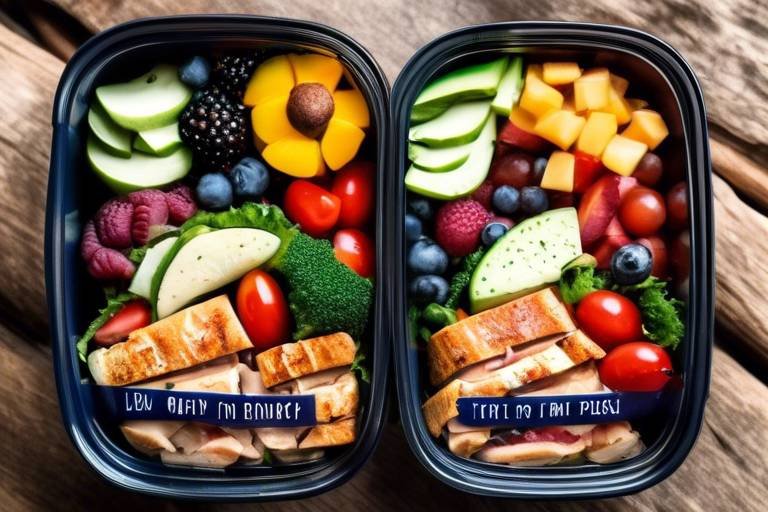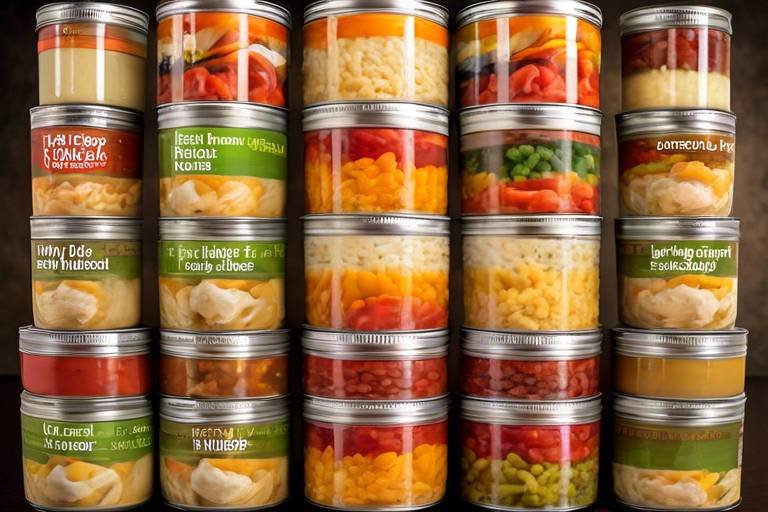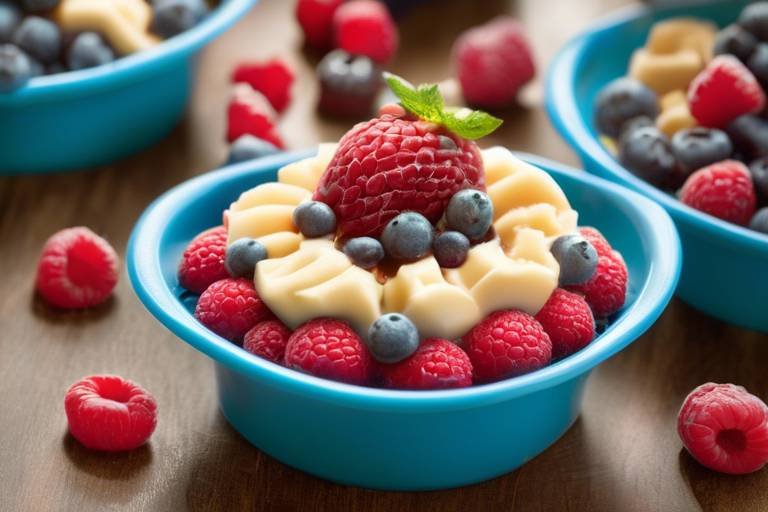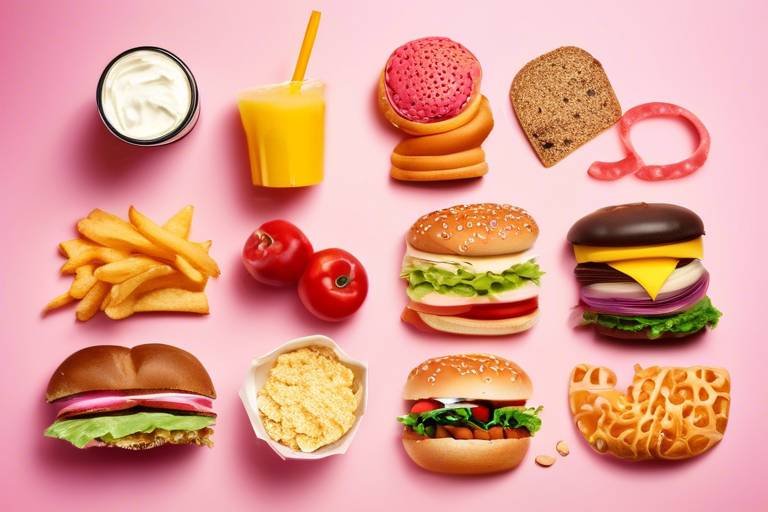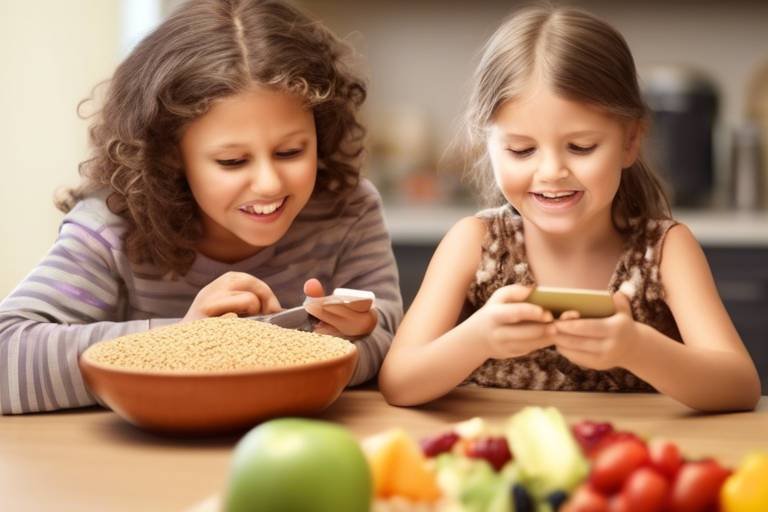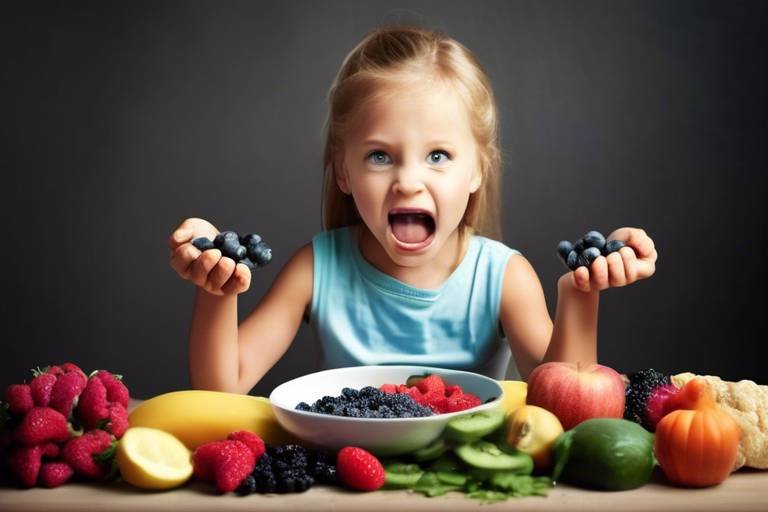The Role of Fruits and Vegetables in Kids' Nutrition
When it comes to our little ones, their nutrition is a top priority for every parent. You might wonder, why are fruits and vegetables so essential in kids' diets? Well, think of them as the building blocks for a child's growth and development. Just like a sturdy house needs a solid foundation, children need a variety of nutrients to support their busy lives and growing bodies. Not only do these colorful foods provide a wealth of vitamins and minerals, but they also come packed with fiber, which is crucial for digestive health. Imagine fruits and vegetables as nature's multivitamins, offering a delicious way to boost immunity and energy levels!
Moreover, the benefits of incorporating fruits and vegetables into your child's meals go beyond physical health. They play a significant role in preventing chronic diseases later in life. Studies suggest that kids who consume a diet rich in these foods are less likely to develop conditions like obesity, heart disease, and diabetes. So, by making fruits and veggies a staple in their diet, you're not just feeding them well today; you're setting them up for a healthier tomorrow. It’s like planting a seed today that will grow into a strong tree in the future!
Now, let's talk about how we can make these nutritious foods more appealing to our kids. Have you ever noticed how vibrant and enticing a plate of fresh fruits and vegetables can look? The explosion of colors can be a feast for the eyes! You can encourage your children to eat more by presenting fruits and veggies in fun and creative ways. For instance, turning a simple fruit salad into a rainbow of colors or creating vegetable characters on their plates can spark their interest. When kids are involved in the kitchen, they are more likely to try new things. So, why not let them help wash, peel, or even chop (with supervision, of course) their favorite fruits and vegetables? This hands-on approach can transform mealtime into an exciting adventure!
In conclusion, the role of fruits and vegetables in kids' nutrition cannot be overstated. They are vital for physical growth, disease prevention, and overall well-being. It's all about making these foods a fun and integral part of your child's diet. Remember, every small step counts. As parents, you have the power to shape your children's eating habits and ensure they enjoy a colorful, nutritious future!
- How many servings of fruits and vegetables should my child eat each day? The recommended intake varies by age, but generally, children should aim for at least 5 servings of fruits and vegetables daily.
- What are some easy ways to incorporate more fruits and vegetables into meals? Try adding fruits to breakfast cereals, blending vegetables into smoothies, or serving raw veggies with dips as snacks.
- What if my child refuses to eat fruits and vegetables? Be patient and persistent. Introduce new items gradually and try different cooking methods to find what they like best.
- Are frozen or canned fruits and vegetables as nutritious as fresh ones? Yes! Frozen and canned options can be just as nutritious, especially if they are processed without added sugars or sodium.

Benefits of Fruits and Vegetables
When it comes to nurturing our little ones, fruits and vegetables play a starring role in their overall health and development. These vibrant, colorful foods are packed with essential vitamins, minerals, and fiber that are crucial for growing bodies. Imagine fruits and vegetables as nature's multivitamins, offering a plethora of nutrients that help children thrive. For instance, vitamin C found in oranges and strawberries supports the immune system, while calcium in leafy greens aids in strong bone development. It's like giving your kids a shield against illnesses!
Moreover, the fiber in fruits and vegetables is a game-changer for digestive health. It keeps things moving smoothly in their tummies and helps prevent constipation, which can be a common issue for kids. Think of fiber as the friendly janitor of the digestive system, sweeping away any blockages and keeping everything tidy. Additionally, a diet rich in fruits and veggies has been linked to a lower risk of chronic diseases later in life, such as obesity, diabetes, and heart disease. So, by encouraging healthy eating habits now, you're setting your kids up for a healthier future.
But that’s not all! Fruits and vegetables also provide antioxidants, which are compounds that help protect the body from damage caused by free radicals. These free radicals can contribute to various diseases, so having a diet high in antioxidants is like giving your kids a superhero cape to fight off those harmful invaders. Foods like blueberries, carrots, and spinach are excellent sources of these protective nutrients.
In addition to physical health, the benefits of fruits and vegetables extend to mental well-being. Studies have shown that children who consume a diet rich in these foods tend to have better moods and improved cognitive function. It’s like fueling their brains with high-quality energy! When kids eat well, they are more likely to focus in school and engage in play, leading to a well-rounded childhood experience.
To make this information even more digestible, here’s a quick overview of some key benefits:
- Boosts Immune System: High in vitamins that help fend off illness.
- Supports Digestive Health: Fiber helps prevent constipation.
- Reduces Risk of Chronic Diseases: Aids in preventing obesity and heart disease.
- Provides Antioxidants: Protects the body from cellular damage.
- Enhances Mental Well-being: Improves mood and cognitive function.
In conclusion, incorporating a variety of fruits and vegetables into your child's diet is not just beneficial; it's essential. By making these foods a regular part of their meals, you're giving them the tools they need to grow strong, stay healthy, and thrive in all aspects of life. So, the next time you’re at the grocery store, think of fruits and veggies as the ultimate power foods for your little superheroes!

Recommended Daily Intake
Understanding the recommended servings of fruits and vegetables for children is essential for balanced nutrition. The U.S. Department of Agriculture (USDA) suggests that children should consume a variety of fruits and vegetables daily to meet their nutritional needs. But how do you know what’s right for your little ones? Well, it all boils down to their age, activity level, and individual dietary requirements. Let's break it down!
For toddlers aged 1-3 years, the recommendation is about 1 cup of fruits and 1 cup of vegetables each day. This might seem like a small amount, but remember, their little tummies can only hold so much! For preschoolers aged 4-5, the intake increases slightly to 1 to 1.5 cups of fruits and 1 to 1.5 cups of vegetables. Now, if you have school-age kids (6-12 years), they should aim for about 1.5 to 2 cups of fruits and 1.5 to 2.5 cups of vegetables daily. It’s all about growing and staying active!
| Age Group | Fruits (cups/day) | Vegetables (cups/day) |
|---|---|---|
| 1-3 years | 1 | 1 |
| 4-5 years | 1 - 1.5 | 1 - 1.5 |
| 6-12 years | 1.5 - 2 | 1.5 - 2.5 |
Now, you might be wondering, "How do I make sure my kids are getting these servings?" Well, here are a few tips: incorporate fruits into breakfast, like adding bananas or berries to cereal or yogurt. For lunch, toss some colorful veggies into a sandwich or serve them with hummus as a snack. Dinner can be a fun opportunity to experiment with different vegetable stir-fries or salads. The key is to make fruits and vegetables accessible and appealing.
It's also important to note that the variety and color of the fruits and vegetables matter. Different colors often indicate different nutrients, so aim for a rainbow on your plate! This not only keeps meals exciting but also ensures your child is getting a wide range of vitamins and minerals to support their growth and development.
In summary, by understanding the recommended daily intake of fruits and vegetables, you can better plan meals that are not only nutritious but also enjoyable for your kids. It's about creating a habit that will last a lifetime! So, roll up your sleeves and get ready to make healthy eating a fun adventure for your little ones.
- How can I get my child to try new fruits and vegetables? - Try involving them in the shopping and cooking process. Kids are more likely to eat what they help prepare!
- What if my child refuses to eat vegetables? - Don't give up! Keep offering them in different forms, like smoothies or purees, and try to make them fun.
- Are frozen fruits and vegetables just as nutritious? - Yes! Frozen options can be just as nutritious as fresh ones, often picked at peak ripeness and quickly frozen to preserve nutrients.

Age-Specific Guidelines
When it comes to ensuring that our little ones get the right amount of fruits and vegetables, it's crucial to recognize that different age groups have different needs. Just like how a toddler's tiny hands can't hold a whole apple, their nutritional requirements are also on a smaller scale compared to older children. Understanding these guidelines can help parents tailor their meals effectively, making sure that each bite counts towards their child's health and development.
For toddlers aged 1 to 3 years, the general recommendation is about 1 cup of fruits and 1 cup of vegetables each day. At this stage, children are exploring new flavors and textures, so it's essential to introduce a wide variety of options. Think of it as a colorful adventure on their plate! For instance, diced bananas, steamed carrots, or sweet potato mash can be both fun and nutritious.
As kids grow into preschoolers (ages 4 to 5), their intake should increase slightly to about 1 to 1.5 cups of fruits and 1 to 1.5 cups of vegetables daily. This is the perfect time to introduce them to the concept of “eating the rainbow.” By incorporating fruits and vegetables of different colors, you not only make meals visually appealing but also ensure a range of nutrients. For example, red bell peppers, green peas, and purple grapes can all be included in their diet, providing essential vitamins and minerals.
Once children reach school age (ages 6 to 12), the recommended intake rises to about 1.5 to 2 cups of fruits and 1.5 to 2.5 cups of vegetables per day. At this stage, children are more active and their bodies require more fuel. It’s a great opportunity to involve them in meal planning and preparation, making it a fun and educational experience. You could create a simple chart together to track their fruit and vegetable intake, turning it into a game where they earn points for trying new items!
To make it even clearer, here's a quick reference table summarizing the age-specific guidelines:
| Age Group | Recommended Daily Fruit Intake | Recommended Daily Vegetable Intake |
|---|---|---|
| Toddlers (1-3 years) | 1 cup | 1 cup |
| Preschoolers (4-5 years) | 1-1.5 cups | 1-1.5 cups |
| School Age (6-12 years) | 1.5-2 cups | 1.5-2.5 cups |
In conclusion, understanding these age-specific guidelines is not just about meeting nutritional needs; it’s about laying the foundation for a lifetime of healthy eating habits. By making fruits and vegetables a regular part of their diet, parents can help their children develop a taste for nutritious foods that will benefit them for years to come. So, the next time you're shopping or preparing meals, remember that every fruit and vegetable is a step towards building a healthier future for your kids!

Portion Sizes
Understanding portion sizes for fruits and vegetables can feel like navigating a maze, especially for parents trying to ensure their kids are getting the right nutrition. It's crucial to remember that the appropriate serving sizes can vary based on age, activity level, and individual preferences. To simplify this process, let’s break it down by age groups, which will help you make informed choices when planning meals.
For toddlers, a serving size is typically about 1/4 cup of fruits or vegetables. Think of it as a small handful or a few bites—enough to introduce them to the flavors without overwhelming their little tummies. As children grow into preschoolers, the serving size increases to approximately 1/2 cup. This is the age where they start exploring different tastes, so it's a great opportunity to introduce a variety of colors and textures.
When kids reach the school-age stage, they should aim for about 1 cup of fruits and vegetables per meal. This is where you can get creative! You can mix fruits into their breakfast cereal or pack colorful veggie sticks for their lunch. Here's a quick reference table to help you visualize the portion sizes:
| Age Group | Recommended Serving Size |
|---|---|
| Toddlers (1-3 years) | 1/4 cup |
| Preschoolers (4-5 years) | 1/2 cup |
| School-age (6-12 years) | 1 cup |
It's also important to consider that can be adjusted based on the child's activity level. For instance, a more active child might need a bit more, while a less active child could be satisfied with slightly smaller portions. Always pay attention to their hunger cues; they are often the best indicators of how much they need. As a parent, you can encourage healthy eating habits by serving appropriate portions without making mealtime feel restrictive.
Incorporating a variety of fruits and vegetables in different forms—whether raw, cooked, or blended—can also help maintain interest and excitement about healthy eating. Remember, the goal is to create a positive experience around fruits and vegetables, helping your kids develop a lifelong love for nutritious foods.

Variety and Color
When it comes to fruits and vegetables, variety and color are not just eye candy; they are essential components of a healthy diet for kids. Imagine a vibrant rainbow on your plate—each color represents different nutrients that your child’s body needs to thrive. For instance, orange and yellow fruits like oranges and bananas are packed with vitamin C and potassium, while green vegetables like spinach and broccoli are rich in iron and calcium. By encouraging your child to eat a wide range of colorful produce, you’re not only making meals more appealing but also ensuring they receive a broad spectrum of essential vitamins and minerals.
It’s fascinating how nature has designed fruits and vegetables to be so diverse in color and taste. Each hue brings its own unique health benefits, which is why it’s crucial to aim for a plate that resembles a painter’s palette. For example, red fruits such as strawberries and tomatoes are loaded with antioxidants that help fight inflammation, while blue and purple options like blueberries and eggplants are known for their brain-boosting properties. By incorporating a variety of colors into your child’s diet, you are essentially giving them a nutritional insurance policy that promotes overall health and well-being.
To make this easier for parents, consider creating a color chart that lists fruits and vegetables by color. This can serve as a fun and interactive way for kids to learn about the different types of produce available. You could even turn it into a game: challenge your kids to eat one fruit or vegetable from each color category every week. Not only does this encourage them to try new foods, but it also fosters a sense of adventure in the kitchen.
Here’s a simple breakdown of fruits and vegetables by color that you can use:
| Color | Examples | Health Benefits |
|---|---|---|
| Red | Tomatoes, Strawberries | Rich in antioxidants, supports heart health |
| Orange/Yellow | Carrots, Oranges | High in vitamin C, boosts immune system |
| Green | Spinach, Broccoli | High in iron and calcium, supports bone health |
| Blue/Purple | Blueberries, Eggplants | Good for brain health, rich in antioxidants |
| White | Cauliflower, Bananas | Contains fiber, supports digestive health |
By making a conscious effort to include a variety of colors in your child's meals, you are setting them up for a lifetime of healthy eating habits. It’s not just about making meals look pretty; it’s about instilling a sense of curiosity and appreciation for the natural world. So, the next time you’re at the grocery store or farmers' market, take a moment to explore the vibrant colors of fruits and vegetables. Let your child pick out something new and exciting, and watch as they become more engaged in their own nutrition journey!

Creative Ways to Encourage Consumption
Getting kids to eat their fruits and vegetables can sometimes feel like trying to convince a cat to take a bath—it's a challenge! But fear not, there are creative strategies that can turn this task into a fun and engaging experience. One effective method is to make fruits and vegetables visually appealing. You can create a colorful fruit salad that looks like a rainbow on their plate or arrange veggies into fun shapes and characters. This not only makes the food more enticing but also sparks their curiosity!
Another fantastic way to encourage consumption is to involve your kids in the kitchen. When children take part in meal preparation, they're more likely to eat what they've helped to create. Let them wash the veggies, mix the salad, or even choose which fruits to add to a smoothie. This sense of ownership can transform their attitude towards these healthy foods. Plus, cooking together is a great bonding experience!
Don’t forget about the power of storytelling. Create fun stories around different fruits and vegetables. For instance, you can tell them that carrots help them see in the dark like a superhero or that spinach gives them the strength of Popeye. Kids love stories, and associating healthy food with exciting narratives can make them more appealing.
Moreover, you can introduce a “fruit and veggie of the week” challenge. Each week, pick a new fruit or vegetable for the family to try. Explore different recipes and preparation methods together, and at the end of the week, have a family taste test. This not only keeps meals exciting but also encourages kids to expand their palates.
Lastly, consider creating a fun reward system. Every time your child tries a new fruit or vegetable, they earn a sticker or a point towards a small reward. This positive reinforcement can motivate them to be more adventurous eaters. Remember, it’s not just about getting them to eat their greens; it’s about making healthy eating a fun and enjoyable part of their daily lives!
- What are some easy fruits and vegetables to start with for picky eaters? Start with sweet fruits like bananas, strawberries, and apples, and vegetables like carrots and cucumbers. These are often more palatable for kids.
- How can I make fruits and vegetables more appealing? Try creative presentations, colorful arrangements, and involving kids in the cooking process to make them more appealing.
- What if my child refuses to eat fruits and vegetables? Encourage trying new foods without pressure, and keep offering a variety of options. It may take several exposures before they accept a new food.

Overcoming Common Barriers
Getting kids to eat their fruits and vegetables can sometimes feel like trying to convince a cat to take a bath—it's a challenge! Many parents face a variety of obstacles when it comes to ensuring their children consume enough of these vital food groups. From picky eaters to time constraints, the struggle is real. But don't worry! There are practical solutions to help you navigate these common barriers and create a healthier eating environment for your little ones.
First off, let's talk about picky eaters. If your child turns their nose up at anything green, you're not alone. Many kids have a natural aversion to new foods, especially fruits and vegetables. One effective strategy is to introduce new options gradually. For instance, try incorporating fruits and veggies into familiar dishes. If your child loves spaghetti, add some finely chopped spinach or zucchini to the sauce. You can also make the experience fun by letting them help in the kitchen. Kids are more likely to eat what they’ve had a hand in preparing. Plus, it’s a great way to spend quality time together!
Another common barrier is time constraints. In our fast-paced lives, preparing healthy meals can sometimes feel like a luxury we can’t afford. However, with a bit of planning, you can create quick and nutritious meals that include fruits and vegetables. Consider batch cooking on weekends. For example, you can prepare a large pot of vegetable soup or stir-fry and store it in the fridge for easy reheating during the week. Additionally, keep a stash of pre-cut fruits and veggies in your fridge. They make for quick snacks and can easily be added to meals without much fuss.
To help you get started, here’s a quick reference table for some easy and healthy recipes that incorporate fruits and vegetables:
| Recipe | Prep Time | Key Ingredients |
|---|---|---|
| Veggie Stir-Fry | 15 minutes | Bell peppers, broccoli, carrots, soy sauce |
| Fruit Smoothie | 5 minutes | Banana, spinach, yogurt, mixed berries |
| Veggie Pizza | 20 minutes | Pita bread, tomato sauce, mozzarella, assorted veggies |
Lastly, let’s not forget about the importance of setting a good example. Children often mimic their parents’ behaviors, so if they see you enjoying a rainbow of fruits and vegetables, they’re more likely to follow suit. Make family meals a colorful affair by including a variety of options on the table. You could even turn it into a game—challenge your kids to taste a new fruit or vegetable each week. This not only makes eating healthy fun but also broadens their palate over time.
In conclusion, overcoming the barriers to getting kids to eat fruits and vegetables is about creativity, planning, and leading by example. With these strategies in hand, you can turn mealtime into a delightful adventure rather than a battleground. Remember, every small step counts, and soon enough, your children might just surprise you with their newfound love for healthy eating!
Here are some common questions parents have regarding fruits and vegetables in their children's diets:
- How can I make fruits and vegetables more appealing to my child? Try fun presentations like fruit skewers or colorful salads. Involve them in the cooking process to spark their interest.
- What if my child refuses to eat fruits and vegetables altogether? Gradually introduce them in small amounts, and don’t force the issue. Sometimes, it takes multiple exposures for a child to accept a new food.
- Are frozen fruits and vegetables as nutritious as fresh? Yes! Frozen options can be just as nutritious and are often picked at peak ripeness, making them a convenient choice.

Picky Eaters
Dealing with can feel like navigating a minefield for many parents. One day, your child might devour a plate of broccoli, and the next, they act like it’s a plate of poison! It's a common scenario, but there are effective strategies to help introduce fruits and vegetables without turning mealtime into a battlefield. First off, it’s crucial to understand that children are often hesitant to try new foods. This reluctance is a natural part of their development, so don’t take it personally. Instead, think of it as a challenge to be tackled with creativity!
One effective approach is to involve your kids in the meal preparation process. When children help wash, peel, or even choose fruits and vegetables at the grocery store, they often feel a sense of ownership over their food. It’s like giving them a backstage pass to their own dinner show! You can also try making fun presentations with the food. For example, create a colorful fruit salad and let your child arrange the pieces into a funny face. Not only does this make the food more enticing, but it also transforms eating into a playful activity.
Another great tactic is to incorporate fruits and vegetables into familiar dishes. For instance, if your child loves pasta, try adding finely chopped spinach or carrots into the sauce. The goal is to sneak in those nutrients without them even noticing! Additionally, you might consider offering a variety of dips, such as hummus or yogurt, to make raw veggies more appealing. Kids love to dip, and it makes the experience more interactive.
Remember, patience is key. It might take several exposures to a new fruit or vegetable before your child decides to give it a try. So, don’t be discouraged by initial refusals. Keep offering, and celebrate small victories—like when they finally take a bite! You can even set up a reward system for trying new foods. For example, if they taste three new vegetables in a week, they get to pick a fun family activity for the weekend. This not only encourages them to try new things but also strengthens family bonds.
Lastly, keep in mind that your own eating habits play a significant role. Kids are like little sponges, soaking up what they see. If they see you enjoying a variety of fruits and vegetables, they’re more likely to want to try them too. So, make it a family affair—set the table with colorful dishes and enjoy meals together. Before you know it, you might just turn your picky eater into a little foodie!
- What if my child refuses to eat fruits and vegetables altogether? Keep offering them in different forms and combinations. Sometimes, it’s all about presentation!
- How can I make fruits and vegetables more appealing? Try fun shapes, colorful arrangements, and dips to make them more enticing.
- Is it okay to use frozen or canned fruits and vegetables? Absolutely! They can be just as nutritious as fresh options, especially if they are unsweetened or low in sodium.

Time Constraints
In our fast-paced world, juggling work, school, and family activities can make it feel impossible to prepare healthy meals, especially ones packed with fruits and vegetables. Many parents find themselves racing against the clock, and when hunger strikes, convenience often wins over nutrition. However, it doesn't have to be this way! With a little creativity and planning, you can whip up delicious, nutritious meals that your kids will love, even on the busiest of days.
One of the best strategies to tackle time constraints is to plan your meals ahead of time. By dedicating just a few minutes each week to outline meals, you can save precious time during the hectic weekdays. Consider creating a simple meal plan that incorporates a variety of fruits and vegetables. For example, if you know Monday is going to be chaotic, plan for a quick stir-fry loaded with colorful bell peppers, broccoli, and carrots. Not only does this save time, but it also ensures your kids are getting their daily servings of produce.
Another time-saving tip is to prep ingredients in advance. Spend a little time on the weekend washing, chopping, and storing fruits and vegetables in easy-to-reach containers. This way, when it’s time to cook, you can simply grab what you need without the hassle. Think of it like having your very own salad bar at home! You can even get your kids involved in this process—let them choose which fruits and veggies they want to prep. This not only makes them more likely to eat them but also turns meal prep into a fun family activity.
Additionally, consider incorporating quick and easy recipes that highlight fruits and vegetables. Here are a few ideas:
- Smoothies: Blend up some spinach, bananas, and berries for a nutritious drink that’s perfect for breakfast or an after-school snack.
- Veggie Wraps: Use whole grain tortillas and fill them with hummus, sliced cucumbers, carrots, and bell peppers for a quick lunch option.
- Frozen Fruit Pops: Puree fruits like mango and strawberries, pour them into molds, and freeze them for a refreshing treat.
Lastly, don't underestimate the power of frozen and canned fruits and vegetables. These options can be just as nutritious as fresh produce and can save you a significant amount of time. Just be sure to choose options without added sugars or preservatives. With these tips in mind, you can overcome time constraints and ensure your kids are getting the nutrients they need, even on the busiest days.
Q: How can I encourage my kids to eat more fruits and vegetables?
A: Get creative! Involve them in meal prep, make fun presentations, and try new recipes together. Kids are more likely to eat what they help create.
Q: What are some quick meal ideas that include fruits and vegetables?
A: Smoothies, veggie wraps, and stir-fries are all quick options. You can also make salads or use frozen veggies in pasta dishes.
Q: Are frozen fruits and vegetables as healthy as fresh ones?
A: Yes! Frozen fruits and vegetables can be just as nutritious as fresh ones, especially if they are flash-frozen shortly after harvesting.
Frequently Asked Questions
- Why are fruits and vegetables important for my child's diet?
Fruits and vegetables are packed with essential vitamins, minerals, and fiber that are crucial for your child's growth and development. They help prevent diseases, support a healthy immune system, and promote overall well-being. Think of them as nature's multivitamins!
- How much fruits and vegetables should my child eat daily?
The recommended daily intake varies by age and activity level. Generally, toddlers should have about 1 cup of fruits and 1 cup of vegetables, while school-age children need about 1.5 to 2 cups of each. It's like filling a colorful plate to keep their bodies running smoothly!
- What are some creative ways to encourage my kids to eat more fruits and vegetables?
Getting creative can make a big difference! Try presenting fruits and veggies in fun shapes, involving your kids in meal prep, or making smoothies together. The more they engage, the more likely they are to eat healthy!
- What should I do if my child is a picky eater?
Picky eating can be tough, but don’t lose hope! Introduce new fruits and vegetables slowly and pair them with favorites. Sometimes, a little sneakiness—like adding spinach to a smoothie—can work wonders!
- How can I include fruits and vegetables in meals when I'm short on time?
Busy schedules can make healthy eating a challenge, but quick recipes can help! Keep pre-cut fruits and veggies on hand, opt for frozen options, or whip up simple dishes like stir-fries or salads. Healthy eating doesn't have to be time-consuming!
- Are there specific fruits and vegetables that are better for kids?
While all fruits and vegetables are beneficial, some are particularly kid-friendly. Think bananas, apples, carrots, and sweet bell peppers. They’re not only nutritious but also easy to pack for snacks!
- How can I make fruits and vegetables more appealing to my children?
Presentation is key! Use colorful plates, create fruit kabobs, or make veggie dips. Sometimes, a little creativity can turn a simple carrot stick into a fun snack that kids can’t resist!


